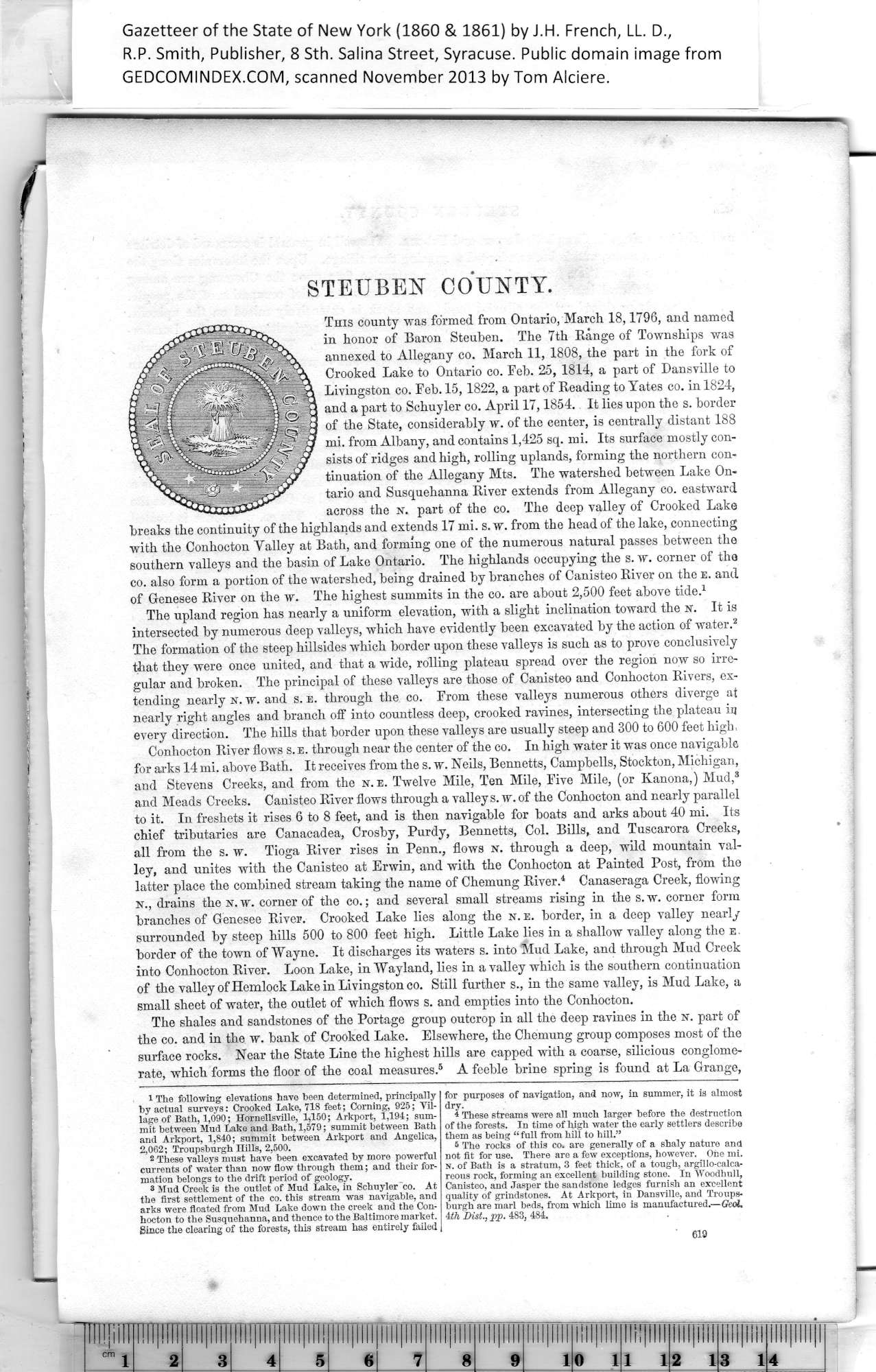|
STEUBEN COUNTY.
This county was formed from Ontario, March 18,1796, and named
in honor of Baron Steuben. The 7th Range of Townships was
annexed to Allegany co. March 11, 1808, the part in the fork of
Crooked Lake to Ontario co. Feb. 25, 1814, a part of Dansville to
Livingston co. Feb. 15, 1822, a part of Reading to Yates co. in 1824,
and a part to Schuyler co. April 17,1854. It lies upon the s. border
of the State, considerably w. of the center, is centrally distant 188
mi. from Albany, and contains 1,425 sq. mi. Its surface mostly con¬
sists of ridges and high, rolling uplands, forming the northern con¬
tinuation of the Allegany Mts. The watershed between Lake On¬
tario and Susquehanna River extends from Allegany co. eastward
across the n. part of the co. The deep valley of Crooked Lake
breaks the continuity of the highlands and extends 17 mi. s.w. from the head of the lake, connecting
with the Conhocton Yalley at Bath, and forming one of the numerous natural passes between the
southern valleys and the basin of Lake Ontario. The highlands occupying the s. w. corner of the
co. also form a portion of the watershed, being drained by branches of Canisteo River on the e. and
of Genesee River on the w. The highest summits in the co. are about 2,500 feet above tide.1
The upland region has nearly a uniform elevation, with a slight inclination toward the N. It is
intersected by numerous deep valleys, which have evidently been excavated by the action of water.2
The formation of the steep hillsides which border upon these valleys is such as to prove conclusively
that they were once united, and that a wide, rolling plateau spread over the region now so irre¬
gular and broken. The principal of these valleys are those of Canisteo and Conhocton Rivers, ex¬
tending nearly n. w. and s. e. through the co. From these valleys numerous others diverge at
nearly right angles and branch off into countless deep, crooked ravines, intersecting the plateau iij
every direction. The hills that border upon these valleys are usually steep and 300 to 600 feet high,
Conhocton River flows s. e. through near the center of the co. In high water it was once navigable
for arks 14 mi. above Bath. It receives from the s. w. Neils, Bennetts, Campbells, Stockton, Michigan,
and Stevens Creeks, and from the n.e. Twelve Mile, Ten Mile, Five Mile, (or Kanona,) Mud,3
and Meads Creeks. Canisteo River flows through a valleys, w. of the Conhocton and nearly parallel
to it. In freshets it rises 6 to 8 feet, and is then navigable for boats and arks about 40 mi. Its
chief tributaries are Canacadea, Crosby, Purdy, Bennetts, Col. Bills, and Tuscarora Creeks,
all from the s. w. Tioga River rises in Penn., flows n. through a deep, wild mountain val¬
ley, and unites with the Canisteo at Erwin, and with the Conhocton at Painted Post, from the
latter place the combined stream taking the name of Chemung River.4 Canaseraga Creek, flowing
N., drains the n. w. corner of the co.; and several small streams rising in the s. w. corner form
branches of Genesee River. Crooked Lake lies along the n. e. border, in a deep valley nearly
surrounded by steep hills 500 to 800 feet high. Little Lake lies in a shallow valley along the e.
border of the town of Wayne. It discharges its waters s. into Mud Lake, and through Mud Creek
into Conhocton River. Loon Lake, in Wayland, lies in a valley which is the southern continuation
of the valley of Hemlock Lake in Livingston co. Still further s., in the same valley, is Mud Lake, a
small sheet of water, the outlet of which flows s. and empties into the Conhocton.
The shales and sandstones of the Portage group outcrop in all the deep ravines in the n. part of
the co. and in the w. bank of Crooked Lake. Elsewhere, the Chemung group composes most of the
surface rocks. Near the State Line the highest hills are capped with a coarse, silicious conglome¬
rate, which forms the floor of the coal measures.3 A feeble brine spring is found at La Grange,
|
for purposes of navigation, and now, in summer, it is almost
dry.
4 These streams were all much larger before the destruction
of the forests. In time of high water the early settlers describe
them as being “full from hill to hill.”
5 The rocks of this co. are generally of a shaly nature and
not fit for use. There are a few exceptions, however. One mi.
N. of Bath is a stratum, 3 feet thick, of a tough, argillo-calca-
reous rock, forming an excellent building stone. In Woodhull,
Canisteo, and Jasper the sandstone ledges furnish an excellent
quality of grindstones. At Arkport, in Dansville, and Troups¬
burgh are marl beds, from which lime is manufactured.—GeoL
4th Dist., pp. 483, 484. |
' 619
1
The following elevations have been determined, principally
by actual surveys: Crooked Lake, 718 feet; Corning, 925; Vil¬
lage of Bath, 1,090; Hornellsville, 1,150; Arkport, 1,194; sum¬
mit between Mud Lake and Bath, 1,579; summit between Bath
and Arkport, 1,840; summit between Arkport and Angelica,
2,062; Troupsburgh Hills, 2,500.
2
These valleys must have been excavated by more powerful
currents of water than now flow through them; and their for¬
mation belongs to the drift period of geology.
3
arks were floated from Mud Lake down the creek and the Con¬
hocton to the Susquehanna, and thonce to the Baltimore market.
Since the clearing of the forests, this stream has entirely failed
|
